
One of the most important parts of chinchilla ownership is making sure your pet lives in an environment that maintains a cool temperature. In the wild, chinchilla live in the mountains, which is a cool environment. Their bodies evolved to suit that environment, which means they’re not fit to live outdoors in many of the places where pet owners have domestic chinchillas.
Chinchillas are very prone to overheating, especially at temperatures above 75F. They don’t have sweat glands and because of their dense fur, their bodies become hot much more quickly than other small mammal pets and have a harder time cooling down. Chinchillas can experience heatstroke at temperatures that most people find comfortable, especially if they’re active or running around. The room their cage is in should be kept within 60 – 70F, and should never be above 74F. If this is not something you can maintain, you should not have a pet chinchilla in your home.
If you’ve recently brought a new pet chinchilla home or are considering adding one to your family, you probably have a lot of questions about how to keep your pet safe and healthy. In this article, we’ll cover how to keep a chinchilla cool, how to recognize heat stroke in a chinchilla, and what you can do to help your chin stay comfortable during hot summer months.
Contents
How to Keep a Chinchilla Cool

The first and most important thing, if you live in any part of the world where the temperature goes about 70F, you must have an air conditioner for the room your chinchilla lives in. Let me say it again: your chinchilla must live in an air-conditioned room. This is not optional. If you cannot provide this for your pet, it is morally wrong for you to have a chinchilla in your home.
If your home doesn’t have central air, you can purchase a window AC unit or single room air conditioner to help maintain the correct temperature for your pet. If you’re worried about the electricity cost, there are a few ways to help mitigate those costs. First, you should be smart about selecting a room for your chinchilla’s cage. Heat rises in homes, so a room on the ground floor or in the basement of your home will be much cooler than a second floor or attic. If you can, select a room that doesn’t get a lot of direct sunlight or invest in energy-efficient blackout curtains to block out the sunlight and the heat.
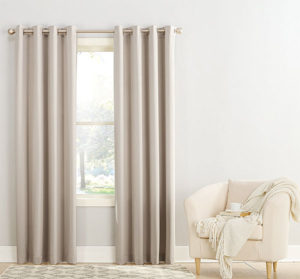 Once you’ve selected a room, position the cage so your chinchilla will not be in direct sunlight or utilize curtains and blinds to keep the sun off your chinchilla. This will help keep them from overheating. It’s also a good idea to keep a thermometer in the room near your chinchilla’s cage. Even if you have a programmable central AC unit, you will not have consistent temperatures throughout the house. You may find the room your chinchilla is in needs more or less AC compared to the rest of the house. (It’s also important to remember in the winter months to not position the cafe near a heater vent or radiator. They can easily overheat next to a heat source even if the rest of the house is much colder.)
Once you’ve selected a room, position the cage so your chinchilla will not be in direct sunlight or utilize curtains and blinds to keep the sun off your chinchilla. This will help keep them from overheating. It’s also a good idea to keep a thermometer in the room near your chinchilla’s cage. Even if you have a programmable central AC unit, you will not have consistent temperatures throughout the house. You may find the room your chinchilla is in needs more or less AC compared to the rest of the house. (It’s also important to remember in the winter months to not position the cafe near a heater vent or radiator. They can easily overheat next to a heat source even if the rest of the house is much colder.)
Humidity can also be an aggravating factor when it comes to maintaining your chinchilla’s body temperature. If you live in an area that has very hot and very humid summers, you may want to invest in a dehumidifier to help keep the humidity under control. The dehumidifier combined with your AC will help keep your chinchilla comfortable and healthy.
Air Conditioning Versus Fans
Many people think that fans will be enough to keep their pet cool. What works for humans does not work for chinchillas. Fans only circulate air, they do not lower the temperature of the air. For humans, we sweat and fans help the sweat evaporate from our skin, which lowers our body temperature. For chinchillas, since they do not sweat, a fan just makes the air move but does nothing to cool their bodies. The only option to keep your chinchilla cool, comfortable, and healthy is to use an air conditioner to maintain an air temperature in the safe range for chinchillas: 60F – 70F.
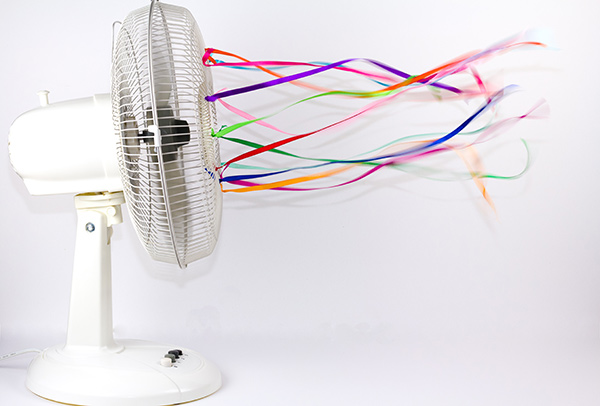
Other Tips to Keep Your Chin Cool
Before playtime in the summer months, lower the temperature in their room by a few degrees to prevent overheating from the extra activity. Consider scheduling playtime in the morning or evening hours when the outside temperature is cooler.
Never transport your chinchilla in a vehicle without an air conditioner. Never leave them in a car unattended.
Never use an exercise ball for your chinchilla. They will overheat within minutes in such a small space. Their playtime should be in a chin-proofed room or a playpen.
Cage Accessories to Cool Your Chinchilla
Chin Chiller Granite Stone
 Whenever people ask me about how to keep a chinchilla cool, the chin chiller is always the first product I recommend. This is one of the most well known and cleverly named products available for chinchillas. It’s a very straightforward product: a slab of naturally cooling granite stone cut to the perfect size for your pet chinchilla. It’s great to use in your chin’s cage or offer in their play area as a cool respite (it’s also a great option to offer to other small pets like rabbits and rats). Granite naturally maintains a temperature below room temp but can be made even cooler by placing it in the refrigerator or freezer. They’re easy to clean, either by spot cleaning or soaking to disinfect as a part of a regular cage cleaning.
Whenever people ask me about how to keep a chinchilla cool, the chin chiller is always the first product I recommend. This is one of the most well known and cleverly named products available for chinchillas. It’s a very straightforward product: a slab of naturally cooling granite stone cut to the perfect size for your pet chinchilla. It’s great to use in your chin’s cage or offer in their play area as a cool respite (it’s also a great option to offer to other small pets like rabbits and rats). Granite naturally maintains a temperature below room temp but can be made even cooler by placing it in the refrigerator or freezer. They’re easy to clean, either by spot cleaning or soaking to disinfect as a part of a regular cage cleaning.
At 6″ x 10″, it’s the perfect size to fit on many cage shelves. I recommend buying a couple of them. I like to keep some in the freezer and rotate them in the cage throughout hot summer months. Even in an air-conditioned room, my chin appreciates laying on something cool, especially after play time.
Stainless Steel Cage Shelves
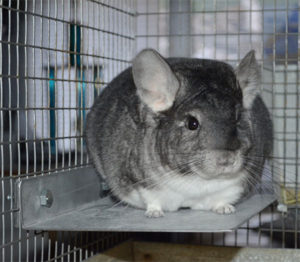 Another fantastic cooling option for your chinchilla’s cage is metal shelves. These are light weight, easy to clean and dissinfect, while doing a double duty in your pet’s cage. They provide a shelve to jump, perch, and sleep on, while also provided a cool surface to help keep your chinchilla’s body temperature down.
Another fantastic cooling option for your chinchilla’s cage is metal shelves. These are light weight, easy to clean and dissinfect, while doing a double duty in your pet’s cage. They provide a shelve to jump, perch, and sleep on, while also provided a cool surface to help keep your chinchilla’s body temperature down.
These shelves are custom made by Tiffany’s Chinchillas and come complete with hardware to bolt the shelf safely to the cage wall with wing nuts. A big pro of these metal shelves is that your chin can’t chew them up and they’re easier to clean and disinfect if your pet pees on them. One or two in your cage will give a nice cool place for your chin to nap on warm afternoons.
Dimensions: 8″ long, 6.5″ wide, 1.5″ back. Weighs 1.6 lbs
Kaytee Terracotta Chinchilla Hideout
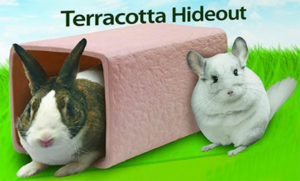 While this terracotta hideout can’t be mounted in your chinchilla’s cage, its a great option to give them a cool a hideway on the floor of their cage. It also works well as a floor toy to give them a break from the heat during play time. Shaped like a tube, your chin can run through it, hop on top of it, and snuggle up or sprawl out inside of it for nap time.
While this terracotta hideout can’t be mounted in your chinchilla’s cage, its a great option to give them a cool a hideway on the floor of their cage. It also works well as a floor toy to give them a break from the heat during play time. Shaped like a tube, your chin can run through it, hop on top of it, and snuggle up or sprawl out inside of it for nap time.
Terracotta is easy to clean and disinfect. It also has the same effect as granite since it stays cooler than room temperature. I don’t recommend freezing terracotta since it can crack and break at extreme temperatures, but an hour or two in the fridge shouldn’t harm it. This is also a good chew-proof alternative if your chinchilla keeps destroying all of their hideouts.
Dimensions: 9.5″L, 7″W, 7″ H
Terracotta Pots
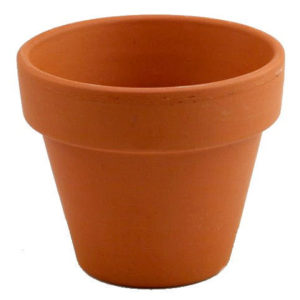 If you’re looking for a budget option to help your chinchilla stay cool, terracotta flower pots work as well as the hideout. You may even have some stacked somewhere in your garage, or you can pick some up for a reasonable price at your local garden center or home improvement store. I would recommend buying a pot large enough that your chinchilla can fit inside the pot or sleep on top of it when turned upside down. The drip trays that come with the pots also work well as a little bed for your chin to cool off on. I would recommend something 9″ or larger for a single adult chinchilla.
If you’re looking for a budget option to help your chinchilla stay cool, terracotta flower pots work as well as the hideout. You may even have some stacked somewhere in your garage, or you can pick some up for a reasonable price at your local garden center or home improvement store. I would recommend buying a pot large enough that your chinchilla can fit inside the pot or sleep on top of it when turned upside down. The drip trays that come with the pots also work well as a little bed for your chin to cool off on. I would recommend something 9″ or larger for a single adult chinchilla.
If you’re reusing a pot found around your house or purchased at a secondhand store, make sure to clean it thoroughly and disinfect it so you won’t pass any bacteria on to your pet chin. Again, don’t free terracotta since it is a little fragile, but feel free to put it in the fridge to lower its temperature even more.
Keeping Your Chinchilla Cool in Emergencies
Even if you’ve done everything you can to create the perfect indoor habitat for your pet chinchilla, there may be situations outside of your control where you can’t control the temperature. During summer heat waves, it’s extremely common for there to be power outages and brownouts or for an AC unit to suddenly die. There are some ways to help your chinchilla stay cool until your air conditioner is working again.
Provide Cool Surfaces to Lounge On – An ice pack wrapped in fleece, a granite slab like the Chin Chiller, or a metal pan or shelf can help lower your chinchilla’s body temperature. Put the marble or metal in the freezer to make it extra cool. Some chinchilla owners will always keep a chin chiller in the freezer in case there is an emergency, or just to offer in their pet’s cage during summer months.
Cover All Windows with Heavy Fabric or Energy Efficient Curtains – Keep the existing cool air in and the hot air and sunlight out by covering the windows.
Relocate Your Chinchilla to a Cooler Area of the House – If you have a basement that is significantly cooler than the room your chin’s cage is in, it might be worth it to temporarily relocate them in their cage or a playpen until the AC issue is resolved. Make sure you’re monitoring your pet if you’re moving them to an environment that isn’t chin-proofed.
Limit Activity – If your AC is out, playtime can wait. You should not take your chinchilla out of their cage to exercise or play, and it may be a good idea to temporarily remove your chinchilla’s wheel to encourage them to chill out and not raise their body temperature.
Chinchilla Heat Stroke Symptoms
One of the most important reasons to know how to keep a chinchilla cool is to prevent heatstroke. If your chinchilla gets too hot while playing or because the temperature in the room is above 70F, it can be very dangerous. If your chinchilla gets heatstroke they can die. You should learn to recognize the symptoms of both overheating and heat stroke and be able to prevent it (by using the tips given previously in the article) and also treat it.
Signs of an Overheating Chinchilla
 If you see these symptoms in your chinchilla, that means they are overheating:
If you see these symptoms in your chinchilla, that means they are overheating:
- Read ears
- Lying sprawled out on their side
- Heavy breathing
You may see these symptoms after your chinchilla has run around for their out of cage time. If you see any of these signs of overheating, you must act immediately to lower your pet’s body temperature. If they’re not already in an air-conditioned room, they must be taken to one immediately. Provide cool surfaces for them to lie on or lean against (like a frozen water bottle covered in fleece or a granite tile). You can even take your chinchilla and hold them in front of your open refrigerator to help cool down their body temperature rapidly.
These solutions should be utilized until your chinchilla’s ears are no longer red and their breathing calms. If your chinchilla seems to be overheating frequently during playtime, lower the temperature in their room and provide some cool surfaces for them to utilize when their body temperature gets too high.
Signs of Chinchilla Heat Stroke
- Extremely low energy or lethargy
- Unresponsive
- Difficulty or unable to walk or stand/li>
- Drooling
- Seizures
- Plus the symptoms described for overheating
If your chinchilla is suffering from heat stroke, it is an emergency. You must bring their body temperature down immediately.
Find a container or bowl large enough to fit your chinchilla. Fill the container with cool water (do not use cold water, ice, or water that has been kept in the refrigerator. Water that is too cold can actually send your chinchilla into shock).
Holding your chinchilla gently, but firmly, submerge them in the water. Keep their head above the water level so they can breathe. It should take 16-20 minutes to bring their temperature back to normal levels, keep them submerged the whole time.
When your chinchilla has cooled down, remove them from the water and dry their fur thoroughly with a towel (do not use a blow dryer, it will just overheat your chinchilla again).
If your chinchilla is willing, offer them some cool water to drink.
Now that your chinchilla is cool, take them to an exotics veterinarian immediately for an examination. This is an emergency. If you cannot take your chinchilla to a vet (the only valid excuse would be if there is not an exotics vet within driving distance of your home), take your chinchilla to a cool area of your home with a temperature under 70F. Make sure there are no drafts or breezes in this area. Observe your chinchilla closely, but do not disturb them too much so they can rest.
Get more tips on how to keep your apartment or house cool during summer without air conditioning.
Keep your chinchilla healthy and safe by putting together a chinchilla first aid kit.
Learn how to bond with your pet chinchilla.
Share on social media

